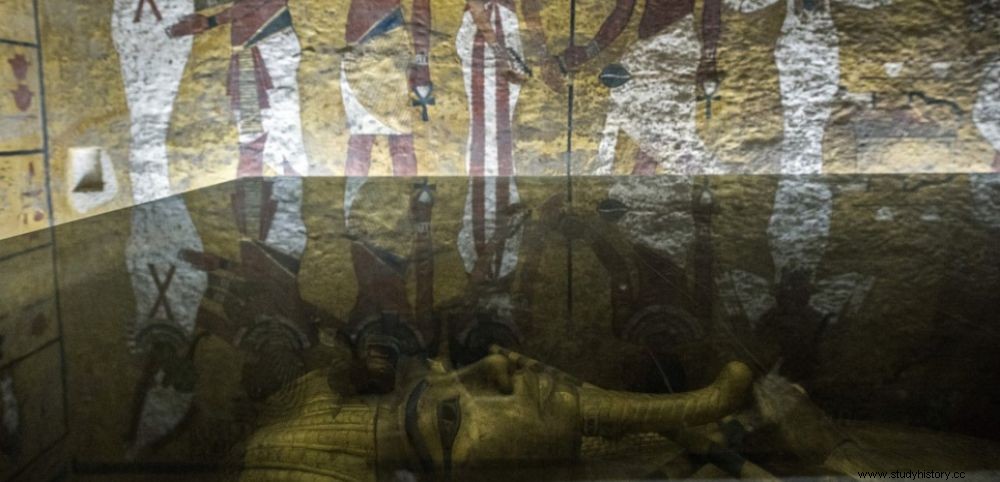 In the tomb of Tutankhamun:a photo taken on September 29, 2015, during the visit of Nicholas Reeves and the Minister of Egyptian Antiquities.
In the tomb of Tutankhamun:a photo taken on September 29, 2015, during the visit of Nicholas Reeves and the Minister of Egyptian Antiquities. TREASURE In the Valley of the Kings, the fever rises near Tutankhamun's tomb, the famous KV62! After the resounding announcement of the hypothesis of Nicholas Reeves - the burial of Nefertiti could be in the tomb of Tutankhamun - then that of the acceptance of its verification by the Egyptian authorities, the archaeologist was in Cairo on October 1, 2015 where he gives a press conference. Already, Monday September 28 the Minister of Egyptian Antiquities, Mamdouh Eldamaty announced, in the presence of Nicholas Reeves, some members of the Supreme Council of Antiquities (CSA) and the cameras of the international press, that the first examinations carried out " by himself and British archaeologist Nicholas Reeves" , on the north and west walls of the tomb of Tutankhamun, in the Valley of the Kings, "may well conceal two burial chambers" .
In a document published online, Nicholas Reeves had claimed that the tomb of Tutankhamun, famous pharaoh of the 18th dynasty, who died in 1323 BC. J.C, after a reign of 9 years, concealed "two doors" secret plastered, then covered with frescoes. One on the side of the west wall of the current burial chamber, another behind the north wall. On the other hand, 80% of the funerary treasures found in Tutankhamun's tomb would be for Nicholas Reeves destined for a woman... And this woman would be Nefertiti, who would have reigned as Pharaoh under the name of Smenkhkare, a poorly known character (a little shared hypothesis concerning the order of succession of the rulers of the 18th dynasty). Reassured about the condition of the walls and traces of "two doors" identical to those crossed (by knocking them down) by Howard Carter in 1922, not to mention the ceiling of the vault which he was particularly keen to inspect, Nicholas Reeves declared "there was nothing else he could do for the instant than waiting for the green light for the use of a radar device and confirming his hypotheses" .
How to access new rooms without damaging the priceless murals?
According to the Egyptian daily Al Ahram , the minister took the opportunity to promise that the radar analyzes would take place on November 4, the anniversary of the discovery of Tutankhamun's tomb 94 years ago, while at the same time, Nicholas Reeves was talking about the end of November. Since his stay in the tomb with the minister, Nicholas Reeves is even more convinced by some of the motifs of the majestic white and gold mural. For the British Egyptologist, the mural on the north wall represents the young King Tutankhamun performing a ritual of the dead for Queen Nefertiti (while most specialists have always seen in this role the Pharaoh Aÿ towards his predecessor Tutankhamun ). According to the Briton, the young Tutankhamun who died prematurely at the age of 19, had to be buried in a hurry in a tomb which was not intended for him. This would have forced priests to reopen that of Nefertiti who died 10 years earlier.
POMPEI. If he thinks it very likely that unknown rooms are hidden behind two of the walls of Tutankhamun's tomb, the minister does not share the conclusions of the Briton as to Nefertiti, as occupying these rooms. The minister is convinced that this sovereign was buried in Tel al-Amarna, the former capital of the kingdom created by her husband Akhenaton "even if her body was never discovered there" . His hypothesis would be more towards Kiya, another wife of Akhenaton (who had many), or even a member of the royal family. Sophisticated exploration equipment and radar equipment (GPR Ground Penetrating Radar*), already used successfully on another tomb a few years ago, are still on hold. Their arrival from Japan would be imminent. A tiny hole could be drilled in the two walls, to introduce a fiber optic camera. In the event of discoveries of unknown pieces, the Ministry of Egyptian Antiquities will make its decisions for the procedure to follow, because the great challenge will be to access these pieces, without damaging the priceless murals. But there is reason to hope, restorers would have already managed to cut and remove mural frescoes in Pompei while keeping them intact...
*GPR is a geophysical device using the principle of radar to study the composition of structures.
OUR PREVIOUS ARTICLES
Nefertiti soon under the radar. On September 23, 2015, we learned that the British archaeologist Nicholas Reeves was authorized to travel to Egypt to verify his hypothesis.
The search for Nefertiti's tomb can begin. The Minister of Egyptian Antiquities expressed his interest in the Egyptologist's theory.
On the trail of Nefertiti. Science and the Future revealed on August 9, 2015 the extraordinary hypothesis of Nicholas Reeves:the burial of Queen Nefertiti could be inside the tomb of Tutankhamun.
